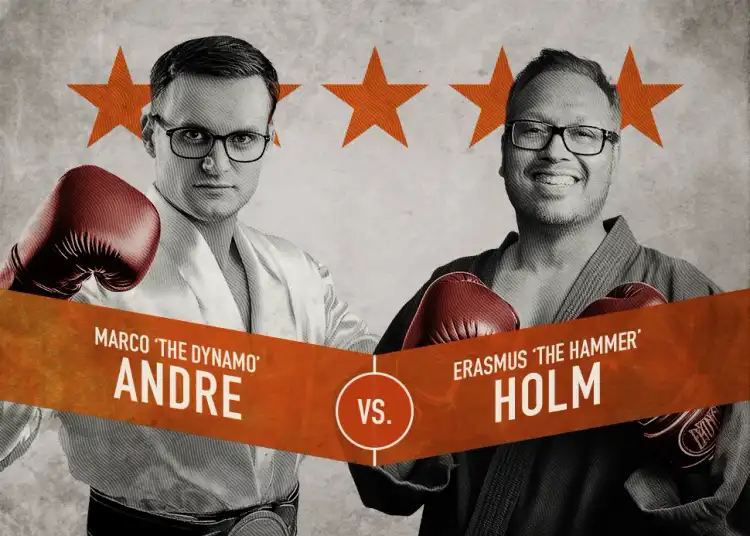What is the Future of Customer Engagement for Pharma: Human or Digital?
Finding the Perfect Balance Between Personal Connection and Digital Innovation in Pharma Engagement.
There’s no doubt – pharma is shifting toward more customer-centric communication models. Engagement is the name of the game – a game we’re all struggling with as doctors get busier and busier and have less interest in being ‘sold’ to. When we engage, we pull HCPs into our commercial and medical ecosystems, helping us understand their challenges, share insights, and provide valuable information about our products.
But here’s the burning question: How do we maintain engagement while attaining clear ROI?
Will it be through the power of human connection, or will digital processes and products take the lead?
At the Next Pharma CX conference in Vienna, there was a heated debate on this topic. You can enjoy the epic battle between man and machine (Erasmus Holm, MSD; and Marco Andre, Novartis, respectively) below, or read on for the summary.
1. Attracting HCPs to Our Ecosystem
The opening question focused on how to attract healthcare professionals (HCPs) into a commercial ecosystem—an essential first step in engagement, often referred to as lead generation or consent capture. The debate began with strong arguments from both sides.
Human-Centered Engagement:
Erasmus, representing the human-centered approach, emphasised the irreplaceable value of human interaction. “We’re in this room because we value face-to-face connections,” he stated, underscoring the nuances humans bring to building trust. He shared compelling data:
- 82% of HCPs prefer personalised insights delivered by real people.
- 75% of HCPs favour in-person engagement for learning about new products.
Erasmus argued that human expertise builds trust and drives stronger relationships, which ultimately convert better than digital-only strategies.
Digital-Driven Engagement:
Marco, advocating for digital, acknowledged the appeal of human interaction but raised a critical point: time. “How much time do HCPs actually have for human connection?” he asked, highlighting the administrative burdens clinicians face. Digital, he argued, streamlines these processes, freeing up time for meaningful interactions.
2. Customer Acquisition and Growth
The debate then moved to customer acquisition and growth—transforming prospects into first-time customers and nurturing them into confident prescribers.
Digital at the Forefront:
Marco introduced the concept of “super doctors” who rely on AI and digital tools for rapid access to information. “If we don’t engage first with digital, we’ll fall flat,” he warned, arguing that digital provides the foundation for relationships by delivering critical information efficiently.
The Human Touch:
Erasmus countered by asserting that complex decisions—especially around high-value products—require the trust and confidence built through face-to-face interactions. He cited data showing that 88% of HCPs trust recommendations from knowledgeable humans over digital channels. “Real relationships equal real returns,” he concluded, emphasising the deep product understanding humans offer.
3. Return on Investment
Return on investment (ROI) emerged as the next battleground. With limited budgets, which approach delivers the most cost-effective results?
Human-Centered ROI:
Erasmus acknowledged that sales representatives are costly but argued they deliver unparalleled value. “Real relationships equal real influence,” he said, sharing anecdotes of long-term loyalty fostered by strong human connections. For example, he mentioned cases where HCPs called sales representatives for guidance on matters unrelated to the product, illustrating the deep trust and loyalty built over years. This relationship-based loyalty, he argued, often translated into consistent support for the product and the brand. He also pointed out hidden costs in digital, such as the need for skilled teams and infrastructure, which can erode perceived savings.
Digital-Centric ROI:
Marco acknowledged the challenges of cutting through the noise in a crowded digital space but maintained that AI and digital tools could amplify impact. He introduced the idea of “Jarvis-like” assistants – smart, AI-driven interfaces that simplify engagement and improve efficiency, ultimately enhancing ROI by scaling interactions.
4. The Next Era of CX Excellence
Looking to the future, both sides explored how their approaches would evolve in an increasingly dynamic healthcare environment.
Digital as an Enabler of Humanity:
Marco proposed that AI and digital tools would paradoxically make engagement more human by eliminating mundane tasks, such as taking meeting notes, sending follow-up emails, or managing repetitive administrative processes. By automating these tasks, he argued, professionals can dedicate more time to meaningful, human-centered interactions. “AI is here to make us more human,” he explained, suggesting that automation frees up time for deeper, more meaningful interactions.
A Hybrid Future:
Erasmus agreed that a balance was essential. “It depends on the product, the market, and the lifecycle,” he said, advocating for a hyper-targeted approach that combines the strengths of both digital and human strategies. “Good marketing and sales will always require both resources.”
Conclusion: A Collaborative Vision
At the start of the debate, the audience leaned heavily in favor of human-centered engagement, as reflected in the initial poll results. However, as the discussion unfolded, both Marco and Erasmus presented compelling arguments that challenged preconceived notions. By the end, the audience’s sentiment shifted towards a hybrid solution, recognising the value of combining the strengths of both approaches. Both experts agreed that the future of pharma customer engagement lies in leveraging the best of both worlds: the efficiency and scale of digital combined with the trust and nuance of human interaction.
Ultimately, customer-centricity must guide every decision, ensuring the right balance of human and digital engagement to deliver optimal outcomes for both HCPs and patients.

Stay ahead with the latest insights, tools, and techniques to make your marketing and medical affairs strategies truly customer-centric. Join over 800 pharma experts on our mailing list and receive expertly curated content delivered straight to your inbox twice a month. Sign Up Below.
Sign Up For Regular Healthcare Marketing Tools and Tips


